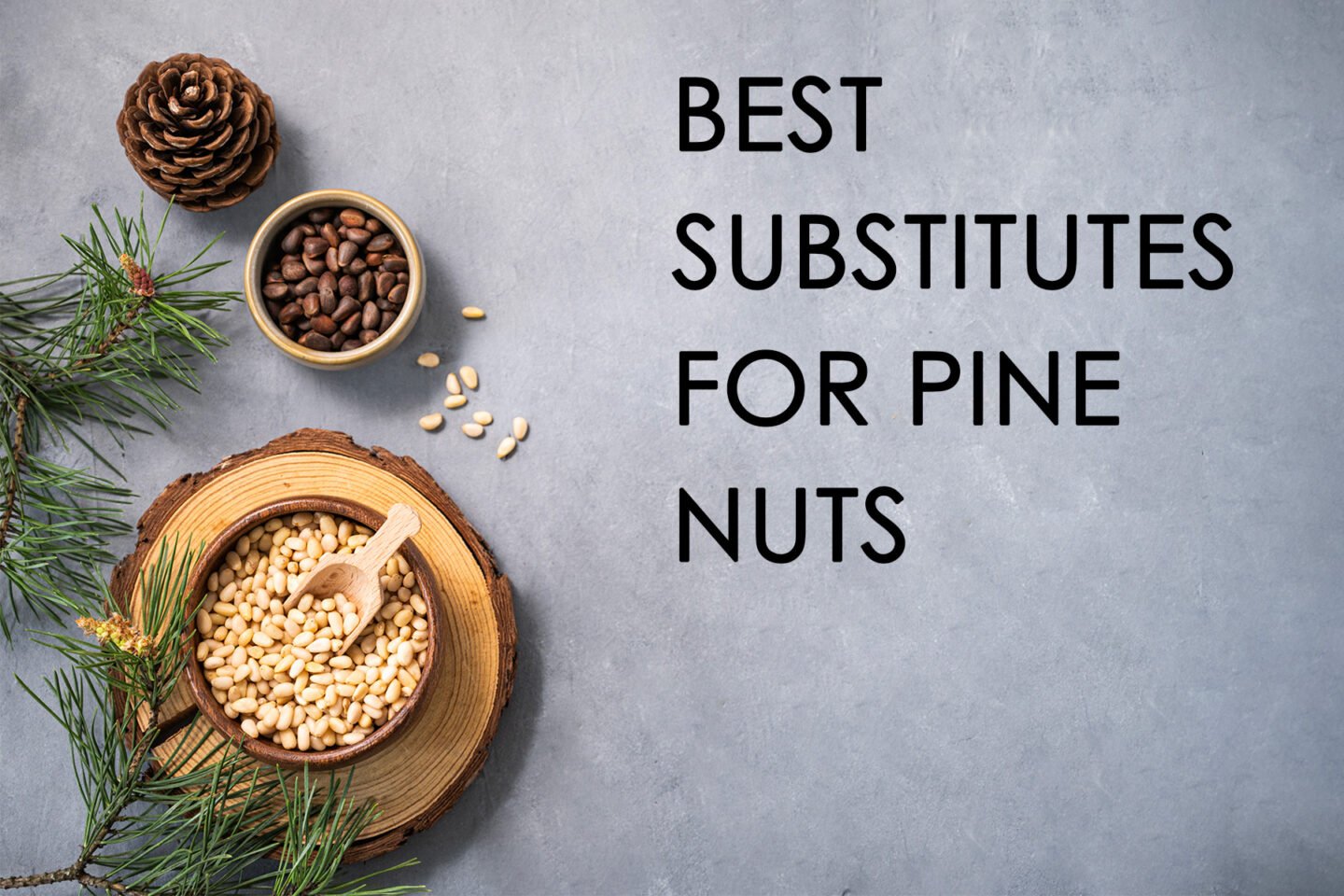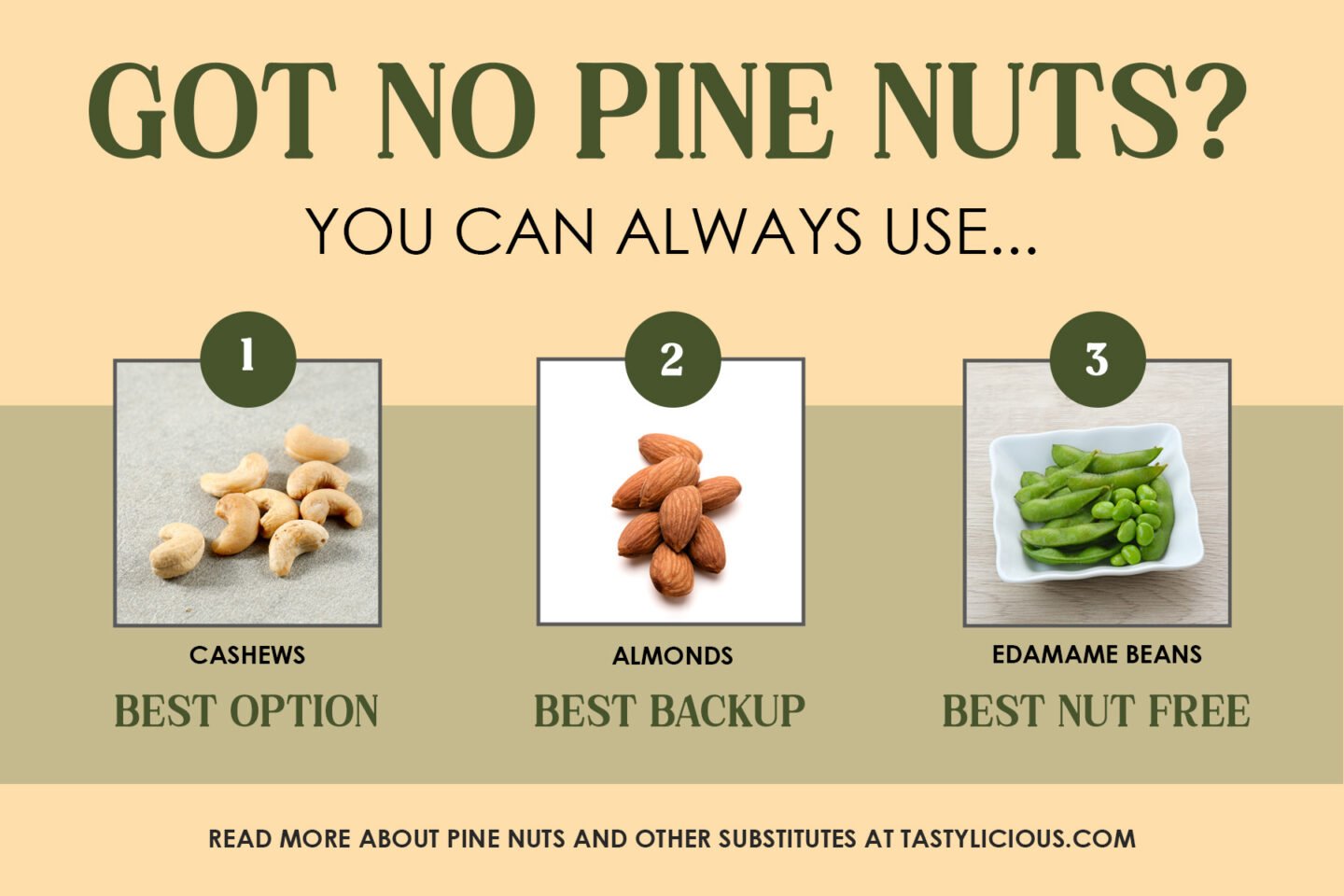Pine nuts are small, mild-tasting seeds that come from pine cones. They have a slightly sweet flavor with a soft, buttery texture. In cooking, they are commonly used in pesto sauce, but they also make a delicious addition to cookies, bread, pasta, and salads.

If you don’t want to splash out on pine nuts or you can’t eat them for health reasons, you’re going to need a replacement. We’ve pulled together a list of the best substitutes for pine nuts so that you can finish any recipe without the original ingredient.
Table of Contents
How do I replace pine nuts in a recipe?
To replace pine nuts in pesto sauce, your best options are cashews, almonds, pistachios, or walnuts. While they have subtle differences in flavor, once processed and combined with herbs like basil, no one will complain. Those searching for a nut-free alternative can use edamame beans or sunflower seeds, which are both good choices. For recipes like salads, pasta, and baked goods, you could also use pecans, hazelnuts, peanuts, or macadamias.
1. Cashews
Cashews make a great substitute for pine nuts. Their soft texture and mildly sweet flavor make them useful in a range of recipes. If you're making pesto, then these nuts should be your first port of call. You may want to try roasting them before adding them to the other ingredients; this will enhance their nuttiness, taking them closer to pine nuts.
If you can buy cashews in pieces rather than whole nuts, you will save yourself some money. They don’t need to be whole because in sauces they will be crushed, and in other recipes like pasta, you chop them into smaller half-inch-long pieces to mimic the size of pine nuts.
2. Almonds
Toasted almonds are another excellent pine nut alternative in pesto and baked treats. Their flavor is unique, but the texture is similar. Like cashews, you need to slice or sliver them into smaller pieces. We recommend soaking the almonds overnight; this will remove the skin, making it look more like a pine nut. When it comes time to use them, give the almonds a light toasting to intensify their taste.
3. Pistachios
Pistachios are a popular ingredient in Italian cuisine, used in sweet and savory dishes. Although a little different than pine nuts, they still make an excellent substitute in pasta, pesto, and salads. When baking them, use unsalted pistachios, or you may take the recipe out of balance with saltiness. In pesto, the green-colored nut goes well with basil, and its slightly sweet flavor is a pleasant addition to the sauce. A few springs of parsley will go nicely with pistachios in pesto.
4. Walnuts
Walnuts are a relatively inexpensive ingredient, but they are great for making pesto. The secret with these nuts is to roast them first and, once cooled, remove the skin to reduce any bitterness. Italians have traditionally used these nuts as a pine nut alternative. It is their go-to ingredient when making Pesto all Genovese. If you use this option in baking, salads, or pasta, chop them into smaller slivers before using.

5. Pecan Nuts
Pecans have a unique flavor that is sweet and buttery, but you could use them as a backup if you're in a pinch. They are higher in oil content, which is what makes them so tasty, but we suggest reducing the olive oil a little if you're making pesto. Pecans are perfect for roasting with honey and crushing before adding to homemade ice cream. Baked goods like cakes, cupcakes, and bread that call for pine nuts will all benefit from pecans. They are a large nut so it is essential to crush or chop them before using in recipes.
6. Hazelnuts
Hazelnuts are excellent when used in Mediterranean and Italian dishes. They are also suitable for desserts and baked goods like bread and cookies. If your recipe calls for pine nuts sprinkled over a salad, then slice up hazelnuts instead and use them to add a pleasant, mildly sweet, nutty crunch.
7. Peanuts
If you're looking for a low-cost alternative to pine nuts, then peanuts would have to be your best option. When raw, they taste a lot like uncooked peas but they also have a buttery flavor that is pleasant in food. While we wouldn't recommend peanuts for use in pesto, they are tasty added to cookies and provide a delicious crunchy texture to stir-fries. Peanuts are often sold honey roasted or with some other ingredients added - these types may taste out of place in some recipes so tread carefully.
Related reading: What's a good substitute for peanut oil?
8. Macadamia Nuts
Macadamia nuts are often quite expensive depending on what part of the world you live in. However, if you've got some in the cupboard then they combine well with parsley and mint to make a pesto sauce. Their flavor is a little more intense than pine nuts but they are still enjoyable with their creamy texture. These nuts are also fantastic added to desserts and if you have any leftover, toss them into your next brownie batter.
Non-Nut Substitutes
If you have a nut allergy then the options we have listed above will not be appropriate for you. Instead, choose from the options below which are all suitable for replacing pine nuts.
9. Edamame Beans
Edamame beans are green soybeans that are often cooked and served at restaurants as an appetizer. When roasted and dried they are mild in taste with a subtle sweet and nutty undertone. The texture of these dried beans is crunchy and they make a tasty pine nut replacement. Although they taste different than pine nuts, you'll find that edamame won't overwhelm sauces or other savory dishes.
10. Sunflower Seeds
Sunflower seeds are excellent for adding crunch too salads and they also make a nutritious addition to bread. They come from dried sunflowers and add a mild, nutty flavor to food. We wouldn't recommend using these seeds in pesto as they impart a grey color into the sauce which may not look appealing.
11. Sesame Seeds
For a nut-free alternative to pine nuts, you could use sesame seeds if you are in a pinch. Sprinkle them into desserts, sauces, or salads but avoid using them in pesto as the texture and taste is noticeably different. We suggest toasting these seeds to help release their aromatic flavor.
Fast Facts About Pine Nuts
- They are relatively expensive as they require more time to mature and removing the “nuts” from their protective case is labor-intensive.
- Some people who eat pine nuts develop pine mouth syndrome which develops one to two days after eating them and results in a metallic taste in the mouth.
- They are packed with nutritional goodness and are high in potassium, manganese, iron, calcium, and magnesium.
Related reading:
What is the best way to replace okra in cooking?
How can you replace plantains in recipes?
Summing Up
Pine nuts are a delicious addition to pasta, salads, sweet recipes, and most commonly pesto sauce. If you can't or won't use them in your next recipe then we recommend using cashews, almonds, pistachios, or walnuts as your best options. For a nut-free option, you can use edamame beans or sunflower seeds which, while tasting different, will still work in most recipes.
Have you got a suggestion which you think would work well for replacing pine nuts? Please let us know in the comments below and we will be sure to check it out.

Leave a Reply